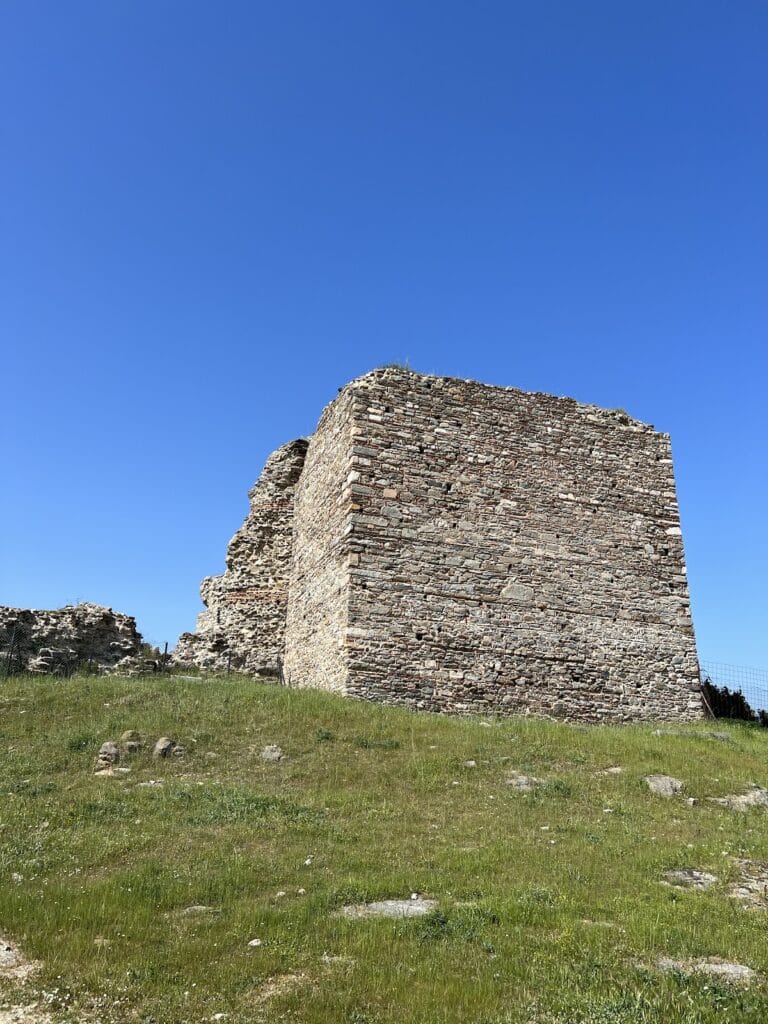Anaktoropolis: A Byzantine Fortress in Eastern Macedonia, Greece
Visitor Information
Google Rating: 4.3
Popularity: Low
Google Maps: View on Google Maps
Official Website: odysseus.culture.gr
Country: Greece
Civilization: Unclassified
Remains: Military
History
Anaktoropolis is a Byzantine fortress situated near Nea Peramos in the municipality of Megalopolis, Greece. Built upon the site of the ancient city of Oisyme, it reflects the strategic concerns of the Byzantine Empire in Eastern Macedonia.
The earliest phases of fortification at the site date between the 6th and 9th centuries, marking its initial establishment in the early medieval period. By the 10th century, the settlement—then known as Alektryopolis—held ecclesiastical significance, appearing as a bishopric subordinate to the Archbishopric of Philippi. A bishop named Georgios is recorded in an official lead seal from the 11th century, indicating continuous religious activity.
Throughout the 11th century, the settlement’s name evolved in documents, shifting from Alektryopolis to forms such as Alektoroupolis and Anaktoroupolis. During the 12th and 13th centuries, the fortress underwent repairs, reflecting ongoing military and administrative importance.
The 14th century brought renewed prominence under the name Eleftheroupolis. Emperor Andronikos III Palaiologos initiated wall renovations, strengthening the site’s defenses. At this time, the fortress passed from the control of Alexios Apokaukos to two brothers from Velikani, Alexios and Ioannis, who established a largely autonomous principality centered on the fortress. These rulers engaged in piracy, adding instability to the region.
Between 1383 and 1387, Ottoman forces captured and destroyed Eleftheroupolis, ending Byzantine control. Despite this devastation, records from the late 15th century still reference the bishopric, highlighting a lingering ecclesiastical presence.
In the 20th century, the fortress ruins saw military use during World War I, when Bulgarian troops stationed themselves there and constructed artillery sites nearby. Shortly after the war, in 1922, Greek refugees from Asia Minor sought shelter within the remains and used materials from the site to build new homes.
Archaeological efforts began with trial excavations between 1974 and 1983, revealing details about the fortress layout and structures. In 1989, a small chapel was uncovered within the site. Between 2011 and 2015, restoration work aimed at preserving the ruins and enabling archaeological study was carried out, including masonry reconstruction and the installation of infrastructure to support future research.
Remains
The fortress of Anaktoropolis occupies the northern slope of a low hill by Eleftheres Bay, enclosing an area about 1.55 hectares in size. Its defensive walls extend nearly 650 meters in length, forming an irregular enclosure roughly 150 meters long from north to south and about 100 meters wide east to west. The walls, constructed chiefly from stone, are approximately two meters thick and originally rose between six and eight and a half meters. Thirteen towers punctuate the walls, arranged closer together where access by land was easier. Their shapes vary, including rectangular, round, and polygonal bases, with tower heights ranging from 7.5 to 9.5 meters; the largest tower in the southeast corner reaches 11.5 meters in height, offering strong defensive capability.
Additional protective features include a lower outer wall on the eastern side, designed to strengthen this more vulnerable flank. The fortress has three known gates: the main one on the western face, a northern gate providing access toward the harbor area, and a smaller southern gate located near the substantial southeastern tower. Scholars believe an eastern gate likely existed, though it has not been definitively identified.
Inside the walls, evidence of religious structures has emerged. Foundations of a small chapel stand in the southeast section, revealing the continuity of Christian worship within the fortress. Near the western gate lies a well, essential for supplying water during sieges. Furthermore, four column capitals from a cross-domed church have been found, thought to belong to the bishop’s cathedral, although no other elements of this church remain in situ.
Outside the fortress, to the west, lie the remains of the settlement’s cemetery, indicating ongoing habitation near the defensive enclosure. The harbor to the north was served by a mole—a stone structure extending into the sea—to protect ships and facilitate trade or military movements. Though much reduced, remnants of this mole remain visible beneath the water.
An important historical feature is a brick inscription embedded in the southern outer wall. Made from flat, elongated bricks arranged to form letters, the inscription is badly damaged, rendering its full content unclear. Academic debate surrounds its date: some readings place it in the late 12th century between 1167 and 1170, while others argue it belongs to 1340 during the reign of Andronikos III, based on references to the eighth indiction year, a method of denoting dates in Byzantine documents.
The recent restoration campaign involved careful reconstruction of approximately 1,250 cubic meters of masonry, stabilizing the fortress walls and towers. Modern infrastructure such as electrical wiring, lighting systems, water supply, and fire protection installations were added to support ongoing archaeological study and preservation efforts, ensuring the site’s structural integrity for future exploration.








